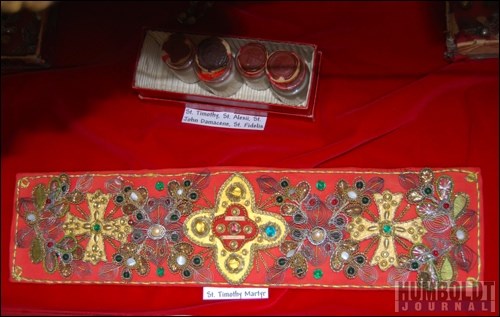Under a glass casing, protected from dust and encapsulated by time, are tiny vials filled with soil from the Holy Land.
On another shelf of the display case there is a bronze statuette venerating Saint Francis of Assisi.
These articles are part of the collection of reliquiae owned by the Sisters of St. Elizabeth and displayed at their convent in Humboldt.
Reliquiae is the latin word for relics, and means literally remains or something left behind. Relics are an important aspect to many religions and as such are usually carefully preserved for memorial purposes.
With over a century of activity in Humboldt, the Sisters of St. Elizabeth have a long, rich history in Saskatchewan dating back to 1911 to draw from. The collection housed by the Sisters at the convent is something that has accumulated over many years. According to Sr. Philomena Dobmeier, there are objects dating back to the 1600s, objects that may have been offered as gifts by visiting dignitaries or brought back as souvenirs by the Sisters from overseas.
Every relic in the collection has a story about how it came to be here.
Some of the items were taken from an altarpiece (the carved decoration behind the altar) when an old church was being rebuilt; others are icons of saints, set into minute picture frames.
Sr. Philomena indicated one of the items in the glass cabinet, explaining that it had been made with a chaplet used by Sr. Walburga Swetlin, one of the Austrian nuns who arrived in Humboldt in 1913.
"They didn't waste anything," Sr. Philomena said about the novices, "whatever they had they used."
The most stunning visually are the samplers made with elements taken from the clergy's clothing, such as pearls, gold braid and embroidered crosses, and set on a rich, vermillion-coloured cloth.
Sr. Philomena emphasized that the value of many of the relics wasn't monetary, but represented the time and dedication that was given to making them, and for what each piece signifies.
There are other examples of the sisters' artistic creativity around the building, such as the stained glass windows in the chapel, designed by Sr. Salesia Zunti. In the lobby near the entrance to the convent, there is a collection of paintings done by Sr. Pauline Thacyk.
The walls of the corridor serve as a portrait gallery for the clergy that have played a role in the convent and in Catholicism in the area since the early 1900s.
The convent may not be found on the list of attractions for visitors to Humboldt, but it is perhaps one of the city's best-kept secrets for its historical value.




